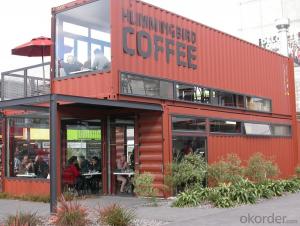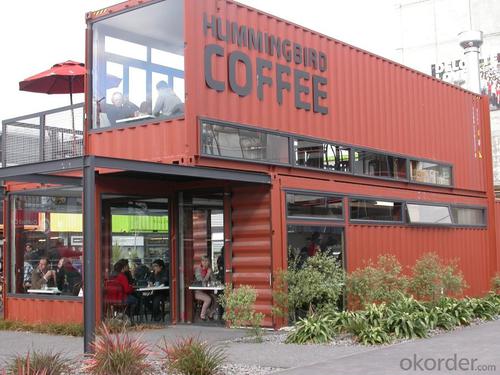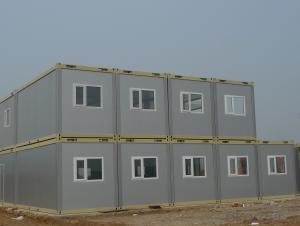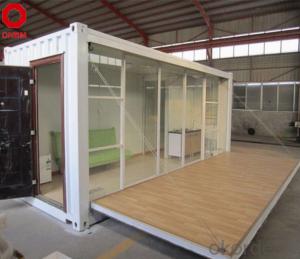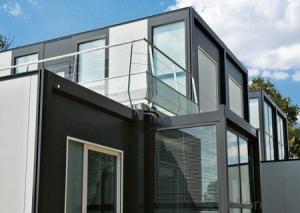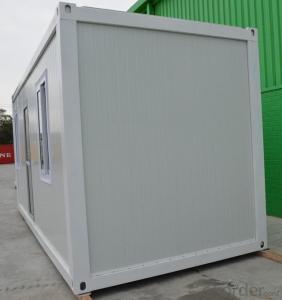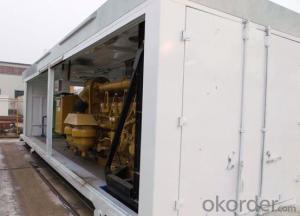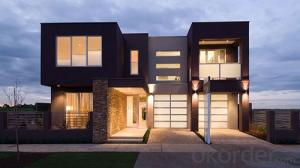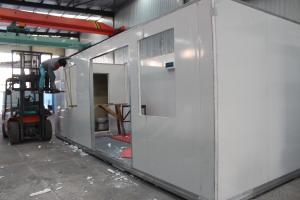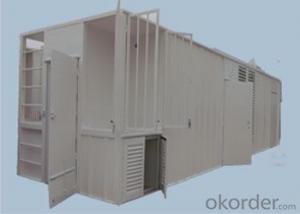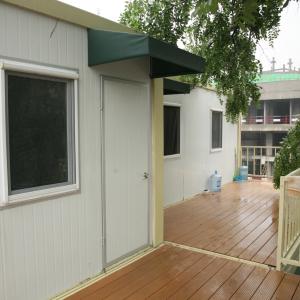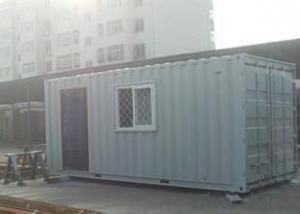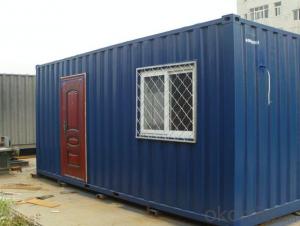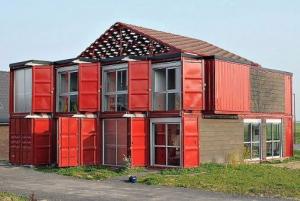modified container house
- Loading Port:
- China Main Port
- Payment Terms:
- TT OR LC
- Min Order Qty:
- -
- Supply Capability:
- -
OKorder Service Pledge
OKorder Financial Service
You Might Also Like
container house
Characteristic:
- ready to live just after the installation on a parcel - made from high quality materials and technologies
- can be used for the whole year thanks to warmth and heating
- more esthetic and solid than classic wooden house or nederland plastic house
- profitable -it guarranties fast repayment. If we use it for rent, after 4 years we can earn money (if we rent for only 4 months during the year)
be prefabricated in factory, transport as a ready object piece by piece, placed exactly on destinated area on a prefabricated fundament blocks
- You don’t have to have a permission for building
- without any hided costs.
Standard version includes:
1. Complete outdoor elevation , as the design showed,(May some color changed for interior funiture)
2. Aluminium window with double glass constructed as a “warm profile”. Gray color
3. Metal entrance door.
4. Warmth by mineral wool with 15cm thickness (floor and walls)and 20cm (roof).
5. Complete electric instalation with terminal, safety box, contacts, LED ceiling lights and TV aerial exit.
6. Complete sanitary instalation with 55 liters electric boiler with ready installation for toiler, shower, sink, kitchen sink and washer . Everything prepared for white montage (The cost of boiler is not included.).
7. Two electric wall heaters and electric toilet heater (optional).
8. Inside walls made of gypsum-carton, painted one layer of white paint
9. Fundament – Every house is put on prefabricated blocks.
The house was designed with care on every detail, because space where we living have a very big influence for our happiness
Accesories:
Every module can have:
1. Recreation terrace: - Basic terrace - standard terrace made of WPC (Wood Plastic composite) material. - Smart-close terrace - terrace, which closes elevation windows, makes additional anti-theft security.
2. Complete equiped interior: - Basic - Basic kitchen furniture, floor panels and painted walls - Deluxe - Interior for VIP’s, with bigger standard of finishing
3. Integrated sunblind over the terrace
4. House alarm with notifications to mobilephone (optional)
Apartement
Module house
Apartament was designes as a self-sufficient, spacious and comfortable summer house for 2-6 person family. It has saloon with kitchen, bedroom, and toilet. Placed on attractive parcel near by the lake, sea or in mountains can be used as a rent house, can be a quest house apartement behind the bigger house.
Bedroom
Module house
Bedroom is designed especially for holiday resorts, camping or for people who are thinking about renting. Designed as a two independent “hotel rooms” with toilet, shower and big terrace which provides perfect contact with nature and relax possibility on fresh air with some privacy at the same time.
Office
Module house Office is perfect as a adjacent office in the garden, near by the production hall, or also as a representative office near by the construction place for example house estates. Office space was designed as a two different room (for example one for work and meeting room) to provide comfortable work for 2-4 people. Module is self-sufficient beceause it has toilet and small kitchen, perfect for office needs.
Transport and installation
ReadyVilla house is transported to parcel as a ready product but piece by piece in the shipping container. Then it’s installed on special prefabricated fundament blocks by our detailed drawing or installation view on site, you only need to level the house and connect water, electricity and gutter exit.
Production time
- Building house in factory - approx. 1 months
-Installation time - approx. 2 days
- Q: Can container houses be designed with a rooftop deck or terrace?
- Yes, container houses can be designed with a rooftop deck or terrace. The modular nature of container homes allows for various design possibilities, including the addition of a rooftop deck or terrace. This feature not only maximizes outdoor living space but also enhances the overall aesthetic appeal and functionality of the container house.
- Q: Can container houses be designed to have a skylight?
- Yes, container houses can definitely be designed to have a skylight. Skylights are a popular feature in many modern homes, and container houses are no exception. With the right planning and design, it is possible to incorporate a skylight into a container house. One approach to adding a skylight to a container house is by using a modified container that already has a roof opening or space for a skylight. This can be achieved by removing a section of the container's roof and replacing it with a skylight or by using a specially designed container with a prefabricated skylight. Another option is to create a custom design where a skylight is added to the container house during the construction process. This may involve cutting an opening in the roof of the container and installing a skylight system that allows natural light to enter the interior space. There are various types of skylights available, such as fixed skylights, vented skylights, and tubular skylights. The choice of skylight will depend on factors such as the size and layout of the container house, the desired amount of natural light, and the overall design aesthetic. Adding a skylight to a container house can bring several benefits. It allows for increased natural light, which can create a more open and spacious feel inside the house. Additionally, skylights can provide passive solar heating during the day, reducing the need for artificial lighting and potentially lowering energy costs. However, it is important to consider the structural integrity and insulation of the container house when adding a skylight. Proper sealing and insulation around the skylight are crucial to prevent leaks, heat loss, or excessive heat gain. In conclusion, container houses can be designed to have a skylight. With careful planning and construction, a skylight can be incorporated into the container house design, providing natural light, energy efficiency, and a unique architectural feature.
- Q: Do container houses require special permits?
- Special permits are typically needed for container houses. The permits required can differ depending on the location and regulations imposed by the local government or building authorities. Container houses are often seen as non-traditional structures, so additional approvals or permits might be necessary to comply with building codes, zoning regulations, and safety standards. These permits can include evaluations of the structure's strength, electrical and plumbing systems, insulation, ventilation, and occupancy. To fully comprehend the permitting requirements for container houses in your area, it is crucial to consult with local authorities or seek professional guidance.
- Q: Are container houses suitable for vacation homes or Airbnb rentals?
- Yes, container houses can be suitable for vacation homes or Airbnb rentals for several reasons. Firstly, container houses are cost-effective compared to traditional homes, making them an attractive option for vacation homes or rental properties. They are relatively cheaper to purchase or build, allowing homeowners to invest in other aspects of their vacation property or potentially offer lower rental rates to attract more guests. Secondly, container houses are portable and can be easily transported to different locations. This mobility feature makes them ideal for vacation homes, as owners can move them to different scenic locations or even rent out the container house to guests in other areas. This flexibility allows for a unique and diverse vacation experience. Additionally, container houses can be customized to fit specific design preferences and requirements. They can be transformed into stylish and comfortable living spaces with all the necessary amenities, such as bedrooms, bathrooms, kitchens, and living areas. With proper insulation and ventilation, container houses can provide a cozy and enjoyable stay for guests. Furthermore, container houses are also environmentally friendly options for vacation homes or Airbnb rentals. By repurposing shipping containers, these homes contribute to reducing waste and utilizing existing resources. Additionally, container houses can be equipped with sustainable features like solar panels, rainwater collection systems, and energy-efficient appliances, further reducing their environmental impact. In conclusion, container houses can be a suitable choice for vacation homes or Airbnb rentals due to their cost-effectiveness, portability, customizable nature, and environmental friendliness. These unique and versatile properties can provide an affordable and memorable vacation experience for guests while offering homeowners the opportunity to stand out in the market.
- Q: Are container houses suitable for artists or creative professionals?
- Container houses can definitely be suitable for artists or creative professionals. One of the biggest advantages of container houses is their versatility and adaptability, which can be particularly appealing to those in the creative field. These houses can be customized and designed to meet specific artistic needs, allowing artists to create their own unique and inspiring living spaces. Container houses offer a wide range of design possibilities. The modular nature of containers allows for easy expansion and modification, giving artists the freedom to create a space that suits their artistic requirements. They can be transformed into spacious studios with ample natural light, providing the ideal environment for painters, sculptors, or any other type of artist. Additionally, container houses can also be designed with specific storage solutions for art supplies, materials, or even gallery spaces to showcase their work. Moreover, container houses are often more affordable than traditional houses or studios, making them an attractive option for artists or creative professionals who may be working on a tight budget. These houses can be built relatively quickly and at a fraction of the cost of a conventional home, allowing artists to invest more in their creative endeavors. Furthermore, container houses are environmentally friendly. They repurpose old shipping containers, reducing waste and making them an eco-conscious choice for artists who are concerned about sustainability. The use of recycled materials can also add a unique aesthetic appeal to the living space, further enhancing the artistic atmosphere. However, it's important to note that container houses may not be suitable for every artist or creative professional. Some artists may require larger or more specific spaces that cannot be easily accommodated by container houses. Additionally, those who value traditional architectural features or historical buildings may not find container houses to be aesthetically appealing. In conclusion, container houses can be a great option for artists or creative professionals looking for a unique, customizable, and cost-effective living space. These houses offer endless possibilities for artistic expression and can be tailored to meet the specific needs of the individual artist.
- Q: Are container houses suitable for eco-friendly living?
- Container houses can indeed be a suitable option for eco-friendly living. These houses are made from repurposed shipping containers, which reduces the demand for new construction materials and minimizes waste. By reusing these containers, we are effectively recycling and reducing the carbon footprint associated with traditional housing construction. Additionally, container houses can be designed to be energy-efficient. With proper insulation and ventilation systems, these houses can effectively regulate temperature, reducing the need for excessive heating or cooling. This helps to conserve energy and lower greenhouse gas emissions. Furthermore, container houses lend themselves well to incorporating sustainable features. They can be equipped with solar panels to generate clean, renewable energy, reducing reliance on fossil fuels. Rainwater harvesting systems can also be installed, enabling homeowners to collect and reuse water, conserving this valuable resource. Container houses also promote sustainable living by encouraging minimalist lifestyles. The limited space within these houses encourages individuals to declutter and live with less, reducing consumption and waste. This minimalist approach aligns well with eco-friendly living principles. However, it is important to note that the sustainability of container houses is also dependent on the materials and practices used during the conversion process. It is essential to ensure that eco-friendly materials are used for insulation, flooring, and finishes, and that the conversion process itself is carried out in an environmentally responsible manner. Overall, container houses can be a suitable option for eco-friendly living. They offer the benefits of recycling and reducing waste, energy efficiency, and the potential for incorporating sustainable features. However, it is important to consider the entire lifecycle of the house, from construction to ongoing maintenance, to ensure that it truly aligns with eco-friendly living principles.
- Q: How are container houses heated and cooled?
- Depending on the specific design and location, container houses have various methods available for heating and cooling. Insulation and passive heating and cooling techniques are commonly used. The container's walls, roof, and floor are insulated to minimize heat transfer and maintain a comfortable indoor temperature, reducing the need for additional heating or cooling. To provide warmth, container houses can utilize different heating systems. Radiant floor heating, electric or gas heaters, and wood-burning stoves can be integrated into the container's interior. For cooling, there are several options. Ventilation is crucial to allow air circulation and prevent heat buildup. Windows, skylights, or vents can be installed to promote natural airflow. Fans or air conditioning units can also be used when necessary. These cooling systems can be powered by electricity or alternative energy sources, depending on available resources and preferences. In addition, container houses can benefit from renewable energy sources such as solar panels, wind turbines, or geothermal systems. These sustainable methods can provide both heating and cooling, reducing reliance on traditional energy sources and minimizing environmental impact. Ultimately, the choice of heating and cooling methods for container houses depends on factors such as climate, budget, energy efficiency goals, and personal preferences. The design and customization of container homes allow for flexibility in selecting the most suitable and efficient heating and cooling solutions.
- Q: Can container houses be designed with a communal garden?
- Yes, container houses can certainly be designed with a communal garden. With proper planning and design, communal garden spaces can be incorporated into the layout of container houses, allowing residents to enjoy the benefits of gardening and fostering a sense of community.
- Q: Are container houses comfortable to live in?
- Container houses have the potential to provide a comfortable living environment, despite their limitations compared to traditional homes. By utilizing proper design and modifications, container houses can offer a pleasant living space. Versatility is a notable advantage of container houses. They can be tailored and adjusted to meet individual preferences and requirements. Whether it's the layout, interior design, or the addition of windows, doors, and insulation, container houses can be designed to optimize comfort and functionality. Moreover, container houses can be equipped with all the necessary amenities to ensure a comfortable living experience. Plumbing, electricity, heating, and cooling systems can all be installed, offering the same level of convenience as conventional homes. Additionally, container houses can incorporate sustainable features like solar panels and rainwater harvesting systems, making them environmentally friendly and cost-effective. It is essential to emphasize the significance of insulation in container houses for comfort. Proper insulation can regulate temperature, minimize noise, and prevent condensation. The inclusion of insulation materials such as foam or spray insulation can greatly enhance the comfort of container houses. Lastly, container houses provide unique benefits that can enhance the overall living experience. They are often more affordable than traditional homes, making homeownership more accessible. Furthermore, their modular nature allows for easy expansion or relocation if necessary, providing flexibility and adaptability. In conclusion, with the right modifications and design choices, container houses can offer a comfortable and enjoyable living situation. Their versatility, customization options, and potential for sustainable living make them a viable and comfortable alternative to traditional homes.
- Q: Are container houses suitable for retirement homes?
- Retirement homes can indeed find container houses suitable. These houses possess various advantages that make them alluring for retirement living. Firstly, their affordability in comparison to traditional housing options makes them an appealing choice for retirees on a fixed income. The cost-effectiveness of container houses enables retirees to allocate their financial resources towards other necessities or activities during their retirement. Secondly, container houses allow for customization and can be designed to meet the specific needs of retirees. With a wide range of floor plans and layouts available, container homes can be easily modified to accommodate accessibility features like ramps, wider doorways, and grab bars. This ensures that retirees can comfortably and safely age in place, without the need for expensive home modifications. Furthermore, container houses require low maintenance and are energy-efficient. They are constructed using durable materials that require minimal upkeep, reducing the need for retirees to spend time and money on repairs and maintenance. Additionally, container homes can be equipped with energy-saving features such as solar panels, energy-efficient appliances, and insulation, which can help lower utility bills and create a more sustainable living environment. Container houses also offer flexibility and mobility, which is advantageous for retirees desiring a more nomadic lifestyle. These homes can be easily transported and set up in different locations, allowing retirees to explore new areas or move closer to family members without the hassle of selling or buying property. Lastly, container houses provide a smaller, cozier living space that can foster a sense of community among retirees. With less square footage to maintain, retirees can focus on building relationships and participating in social activities within their retirement community. In conclusion, container houses can be a suitable option for retirement homes due to their affordability, customization possibilities, low-maintenance nature, energy efficiency, flexibility, and potential for fostering a sense of community. However, it is crucial to carefully consider the specific needs and preferences of retirees before making a decision.
Send your message to us
modified container house
- Loading Port:
- China Main Port
- Payment Terms:
- TT OR LC
- Min Order Qty:
- -
- Supply Capability:
- -
OKorder Service Pledge
OKorder Financial Service
Similar products
Hot products
Hot Searches
Related keywords
